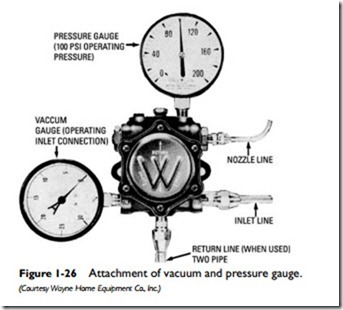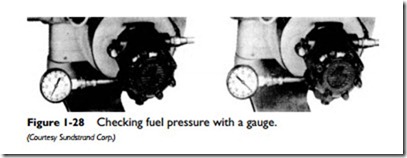Fuel Pump Service and Maintenance
A vacuum gauge and a pressure gauge are both used to service a fuel unit. With these two gauges, the individual can check the following:
• Vacuum
• Lift
• Air leaks
• Pressure
• Cutoff
• Delivery
Figures 1-26 and 1-27 illustrate the attachment of the vacuum and pressure gauges to a fuel unit. The pressure gauge (shown as the upper gauge in Figure 1-26 and the gauge attached to the nozzle line opening in Figure 1-27) will indicate whether a positive cutoff is operable or whether an adequate and uniform buildup of pressure is present. When the pressure gauge is attached to the nozzle line opening, it should indicate a reading of 75 to 90 psi (see Figure 1-27). Any drop of the pressure gauge reading to zero indicates leaky cutoff and probable difficulty with the shutoff valve in the nozzle line.
The existence of air leaks in the supply line can be determined by vacuum gauge readings once the gauge is attached to the optional inlet connection (see Figure 1-26). An evaluation of the gauge reading is itself determined by the location of the oil storage tank. If the tank is located above the burner, and the oil is supplied by gravity flow, the vacuum gauge must show a reading of zero, unless there is a problem in the system. These problems can take the following forms:
• A partially closed cutoff valve of the oil supply tank
• A kinked or partially blocked oil supply line
• A blocked line filter
A system with an oil supply tank located below the level of the oil burner that supplies the fuel oil through a line filter must pro- duce a reading on the vacuum gauge if the system is operating properly. A zero reading will indicate the presence of an air leak.
Table 1-3 lists a few of the problems that may be encountered with fuel units and some suggested remedies for dealing with them. Most manufacturers of fuel units or gauges generally supply troubleshooting recommendations along with the installation and maintenance instructions.
The cause of improper cutoff can be determined by inserting a pressure gauge in the nozzle port of the fuel unit (see Figure 1-28).
Allow the fuel unit to operate for a few minutes and then shut off the burner. If the pressure drops to 0 psi on the gauge, the fuel unit should be replaced. A gauge reading above 0 psi indicates that the fuel unit is operating properly. The probable cause of improper cut- off in those cases where a gauge reading is obtained is usually air in the system.

